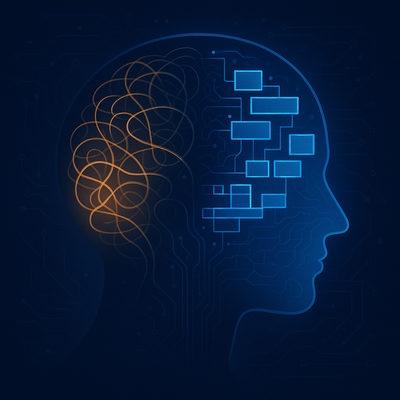Let's say we want to watch a movie with our spouse. Let's take a step-by-step look at how this request will proceed.
First we need to find a good movie. He on the one hand and we on the other hand are looking for movies on our phones that we can recommend to each other.
Our goal is to find a movie that we both say "okay, this one" so that we can both watch it with pleasure and attention.
But in the process our attention can be diverted in many different directions:
- A text message from our family
- A notification of a sale on a product we have been waiting for for a long time
- A sudden craving for something
- A knock at the door
- A movement or sound outside that catches our attention
- An unexpected event such as a violent thunderstorm
And these are just a few examples. You must have experienced dozens of different distractions in similar situations.
In short, we can easily get distracted even when we are trying to choose a movie to watch.
So how can we really watch and enjoy a movie if we have trouble focusing at the beginning?
Let's say we go through this whole process, we find the movie, we start watching it, we need to focus in order to understand it, but the bubble of distracting possibilities is still overhead:
Any moment a new message, notification or other factor can interrupt our attention. We can end up having dialogues like:
Wife: My love, are you watching the movie? If you don't like it, let's turn it off.
We: No, no, I got a notification, now I've turned it off, we can continue...
When such dialogues repeat several times, the enjoyment of the movie can give way to stress and restlessness.
As if that wasn't enough, in the digital age we live in, there are more distractions than ever before.
In the social media feeds we scroll through, every second a different content sends a new alert to our brain. In this article, we will examine the concept of attention from philosophical, scientific, cultural, historical and social perspectives.
We will try to understand the place of focus in the modern world by questioning how we can maintain or improve our attention levels.
Philosophical and Scientific Background
Philosophical Approach:
Simone Weil - The Morality of Attention
French philosopher Simone Weil argues that attention is not only a mental ability to focus, but also the deepest ethical attitude one develops towards the world, others and oneself. Weil emphasizes two aspects of being attentive:
Attention means truly seeing the other.
According to her, to truly grasp another's pain, needs or existence, we need to give our attention to them sincerely. Attention is listening attentively to others without objectifying or judging them.
Attention is a spiritual act.
Weil sees attention as a "prayer", especially in education and thought processes. The attentive person tries to withdraw the ego and grasp the world as it is. This enables one to move away from arrogance and gain humility.
Weil argues that the moral value of attention makes it a virtue:
The person who develops and elevates his attention contributes to society, others and justice as much as he improves himself.
Inattention is the source of both mental laziness and social indifference.
José Ortega y Gasset - The Modern Mind and Distraction
Spanish philosopher José Ortega y Gasset, known for his profound analysis of individual psychology, argues that the mind of the modern man, It is constantly fragmented by technological progress and information overload. This fragmentation weakens the individual's ability to focus.
According to him, distraction is not only a personal problem, but also a philosophical crisis produced by modernity.
Ortega argues that over time people have begun to lose themselves in the technological and cultural environment in which they live, which he describes as the "disintegration of the self".
Ortega's perspective is briefly as follows:
- He equates the loss of focus with the loss of one's own essence and values.
- The modern mind, he argues, is constantly preoccupied with external stimuli, which distracts it from deep thought and inner integrity. This creates a sense of emptiness on a social and individual level.
Ortega's approach is still relevant and striking for understanding the effects of social media and digital environments on people's minds today.
Scientific Approach:
Attention and Neuroplasticity
Neuroplasticity is the ability of the brain to rewire itself according to experiences and habits.
Modern neuroscience research clearly shows that attention and focusing habits permanently shape the structure and functioning of the brain:
Focusing strengthens the brain's "anterior cingulate cortex (anterior cingulate cortex or ACC)" and "prefrontal cortex", which are responsible for higher cognitive functions such as attention control and decision-making.
Trying to pay attention for long periods of time strengthens the pathways that connect cells in the brain and makes these pathways permanent.
Thus, it becomes easier and easier to pay attention.
This cycle is truly a brain-burning cycle.
The more we pay attention, the easier it is to pay attention, our brain gets stronger at what we pay attention to, but the stronger our brain gets, the easier it is to pay attention.
Experimental studies of meditation, mindfulness and deep focus exercises show that even a few minutes of regular practice a day can cause measurable changes in the brain
In contrast, multitasking habits shorten attention spans and weaken the brain's focusing circuits.
In short: How we focus determines how our brain functions. We can think of our attention as a muscle and develop it, because practicing attention activates the neuroplastic capacity of the brain.
If you are interested in this topic, you may also want to watch this:
The Attention Economy and Algorithms
The attention economy is an approach that argues that the most valuable resource in the technological world is users' attention span.
Social media platforms, news sites and mobile apps are designed to capture the attention of users for as long as possible.
The mechanisms consciously used here are:
Infinite scrolling
The user keeps scrolling down without feeling that the content is over. This triggers the release of dopamine and creates an addiction-like effect.
Variable reward system
Similar to slot machines, social media algorithms reward the user with unpredictable notifications, likes or comments, constantly engaging the brain's reward system.
Personalized streams
Algorithms suggest content based on the user's previous interactions, prioritizing what catches the person's attention the most, causing everyone to stay in a constant stream of opinions they agree with.
In addition, content such as personalized ads, ads such as content also give a somewhat sublime feeling, if we say "oh, I was just thinking about it, look, the jacket I wanted came up, so this jacket is written for me to buy", we are likely to be deceived by algorithms trying to manage our attention.
Push notifications and color alerts
Bright colors, vibrations, sounds and constant notifications are used to attract attention. These small "triggers" bring the user back to the app.
Algorithmic sorting
Rather than showing users the "latest" content, platforms show them the content that is "most likely to get the most engagement" and encourage them to spend more time with it.
This means that they take the average of what people like and assume that you are that average person, saying "well, if so many people like it, I guess this one will like it too", so to speak.
In addition, this stream of content keeps our brains busy with the anxiety of "I might miss something".
Conclusion:
Social media and apps, taking advantage of neuroscience research on our brains' reward expectancy and attention focus, see attention as a product to be sold and sell it. The time a user spends in front of a screen becomes a monetary value for these apps, used for advertising revenue, data collection and behavioral analysis.
Thus, consciously managing attention in the digital world becomes critical not only for personal focus but also for psychological independence.
What is Gamma Wave Activity?
Electrical communication in our brain can be measured in the form of "brain waves" of different frequencies.These waves, measured by EEG (electroencephalography) devices, are classified according to how many times they vibrate per second (Hertz/Hz).
Gamma waves are one of the fastest waves in our brain, with a frequency range of about 30-100 Hz.
Research shows that the brain's gamma activity increases markedly during moments of intense focus (e.g. solving a problem, trying to play a piece of music carefully and accurately, being alert to danger).
This increase allows different parts of the brain to work in synchronization, that is, to "focus on the same thing at the same time". In short, gamma waves work like the brain's focal point for attention: whatever we are focusing on, the relevant regions communicate at high speed and spend energy there.
I find this very interesting.
When we focus on positive things, our attention networks for positive things get stronger; when we focus on negative things, those negative connections get stronger, causing our attention to shift to more negative things.
It is as if we hold the key to creating our own heaven or hell.
How does it show up in EEG findings?
In experiments where subjects focus their attention on something, gamma frequencies gain strength (increase in amplitude) in the EEG.
So how do scientists measure this focus?
The EEGs of experienced meditating monks or professional musicians, for example, record strong gamma activity during moments of deep focus. This is like a signature that the brain is operating in a high-performance mode while processing the task it is focusing on.
Why is it important?
Strong gamma activity is crucial for focusing attention, processing information and making connections between different brain regions. Some studies have shown that gamma strength is weak in people with long-term attention deficits.
So improving focus can also support gamma activity.
Societal, Cultural and Historical Perspective:
In order to understand how attention and focus are trained, I think looking at the practices in our own culture as well as in cultures we have been influenced by throughout history can inspire us to grasp the depth of the subject.
Turkish-Islamic culture
Mevlevi Sema Ritual:
The whirling movements of the dervishes during the whirling dervishes in Mevleviism aim to detach the mind from the world and direct it to a single focal point.The combination of music, rhythm and body movement allows the attention to be trained in a holistic experience.
Ottoman Calligraphy:
Calligraphers paid close attention to each letter and line in the aesthetic creation of the script.
Long calligraphy sessions were a way of training the mind through the practice of patience and focus.
Seljuk Madrasa Education:
In the lessons held in madrassas during the Seljuk period, students were trained to pay attention to texts and discussions for long periods of time; focused thinking skills were developed.
Anatolian culture
Mental-Discipline Trainings of the Ahi Organization:
In Ahilik, which formed the basis of the artisan organization in Anatolia, moral and mental discipline was included in vocational training. In the trainings carried out in a master-apprentice relationship, attention and self-control were developed and the ideal of doing error-free work was instilled.
Savvufi tradition, Arab and Persian influences
Zikr Rings:
In dhikr rings, which were widespread in the Ottoman geography and influenced by Arab and Persian cultures, focus was deepened through repeated chanting and rhythmic movements.
Real Problems and Solution Suggestions
Problem:
We pick up the phone every time we receive an alert, lest we miss the notifications.
The content we follow is constantly refreshed.
There is constant pressure to perform well and information overload to earn more money, which reduces our attention span to seconds.
Solution Suggestions:
But we understand that we need to pay attention; as we focus on things that are good, things that bring us peace, our neuron connections strengthen and it becomes easier and easier to pay attention to them.
Maybe we can try things like:
Keeping an attention diary:
We can note the times of the day when we are able to focus and the times when we are distracted.
Notification diet:
We can try to clarify the times of the day at which we will allow notifications and thus strengthen our level of attention protection.
Preventing random notifications can reduce our mind's constant alertness. In this way, we can more easily redirect our focus to the tasks or moments we really value.
Mental breaks
After 50 minutes of focusing, we can try taking 10-minute mindfulness-based rest breaks.
This cycle can refresh our mind and allow us to start the next focus period more efficiently. It can also help to gradually extend our attention span.
Micro-meditation
We can try doing short 1-2 minute breath-focused mindfulness exercises throughout the day. These mini-breaks can prevent our mind from wandering and help us to maintain a more stable level of focus throughout the day. It can also prevent stress from building up, making us feel calmer and more balanced.
Conclusion and Message to the Reader
Attention is not just a mental skill, as we think. It is actually like a huge network of skills that extends from our heart to our culture, from our history to the biological rhythm of our body.
It is useful to be honest with ourselves, regaining the attention we have lost will not end by saying "I muted notifications, everything is solved".
It also requires changing the autopilot of our brain, transforming our reflexes.
Then a question for you:
Have you been able to give your attention to what you really want today, or has your attention drifted to where others have planned? Attention is not just focus; it is the most powerful choice that determines who we are and who we will become.
In my next post, we will dive into the existential crisis and talk about who we are, what we really want and how these questions shape our lives.
Till then, stay in love.









